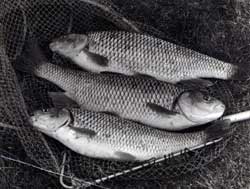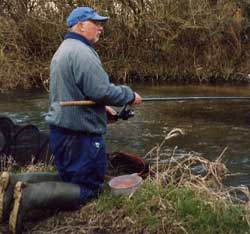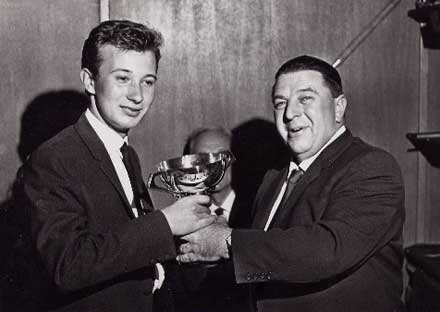| MARK WINTLE |
| Mark Wintle, an angler for thirty-five years, is on a quest to discover and bring to you the magic of fishing. Previously heavily involved with match fishing he now fishes for the sheer fun of it. With an open and enquiring mind, each week Mark will bring to you articles on fishing different rivers, different methods and what makes rivers, and occasionally stillwaters, tick. Add to this a mixed bag of articles on catching big fish, tackle design, angling politics and a few surprises. Are you stuck in a rut fishing the same swim every week? Do you dare to try something different and see a whole new world of angling open up? Yes? Then read Mark Wintle’s regular weekly column. |
A DAY ON THE WINDRUSH With just two weekends of the river season left, I finally managed to organise a trip to the Windrush. In the circumstances it was a case of making the best of it, for the lack of rain over the previous month left the Windrush low and very clear. Ideally, we would have waited for perfect conditions but with time running out the trip had to go ahead. Though we had few doubts about finding some sport we knew that it would be tricky to tempt the fish. The weather forecast was for no frost, with some cloud cover, and little wind, so at least it would be pleasant to be out in the countryside. My host for the day was my old friend Jimmy Lee, who grew up in Witney, and although he left there over thirty years ago, still manages an occasional trip despite being a fanatical golfer nowadays. Over the past forty years, the Windrush has changed. In place of the huge dace (one or two remain) there are now many barbel, fish that were almost completely absent in the fifties and sixties. These are not generally huge barbel but the shoals are sizeable for such a small river. For those that do not know it, the Windrush is a small Cotswold river that is fed by springs from the limestone, and though mainly a trout stream above Witney, it holds a good head of coarse fish from there down to its confluence with the Thames at Newbridge. The river looks similar to some of the Dorset, Hampshire and Wiltshire streams though the gravel is limestone pebbles rather than flint.
Jimmy likes to take his fishing at a leisurely pace so we didn’t arrive in Witney until after ten, and after parking the first job was a quick look at a few likely swims. As we suspected the river was low, though there were healthy beds of bright green ranunculus in the faster swims. Here and there we spotted a chub or two; fish between a pound and two pounds, and in one swim a barbel of about four pounds accompanied a couple of chub. Jimmy suggested that I try three or four swims upstream whilst he concentrated on the field below the old, derelict mill. The river is in two parallel streams from Witney almost until it joins the Thames and we had access to both parts. Initially the main river looked the best bet though the barbel was in the millstream. I fancied a long glide down to a vast flood raft and began by trotting maggots under a small alloy-stem stick float. Before starting, I fed the swim for a few minutes. Bites were quickly forthcoming but, alas, they were the perennial curse of the Windrush, dirty great minnows. I’d only been fishing for thirty minutes when Jimmy appeared. He’d already had two chub and an out of season brown trout, and lost another chub and trout. He suggested that I move up to the top boundary where a gully right under some far bank tree roots looked like it ought to hold a chub. It started to look like the few fish that were about were going to be tight into the few tiny areas of cover.
The gully at the top of the stretch looked inviting. Just before Jimmy had appeared I had switched to fishing with flake on a twelve and a 3BB Drennan wire-stem Avon using mashed bread as feed to see if this would beat the minnows (it didn’t), but as my rod was now set up like this I tried flake as my opening gambit. The branches from the far bank trees left just one tiny gap to get the float into. To do this I used a gentle under-hand swing and the float dropped in tight against the far bank. After feeding a ball of mashed bread, I eased the float down the swim, and after five yards, it stabbed under. I struck and found myself attached to a lively chub. It was no monster at about two pounds and despite the many snags, I had no problems landing it. I was sure there were more along the roots but despite changing back to maggots, I got no more bites. The overhanging trees made life difficult, and after trying for another half an hour I moved back down to a swim where earlier we had spotted a couple of chub. The chub were still there but tucked into a tiny pocket of water under the far bank. The river here comes off a fast shallow into a pool. The fish aren’t in the pool at all. The pocket where the chub were is so small that it was difficult to cast into it without spooking the chub. I started by feeding so that some of the loose fed maggots were falling where the chub were holed up. After ten minutes, the chub came out of the pocket and I cast in and got a bite. It was another chub of about a pound and a half. After landing it I fished on but the two other chub were determined to stay right in the tiny pocket. I was able to drop the float in the pocket but it scared them, and the brisk current quickly pulled the float away. In hindsight, the best way to tackle such a swim would be by using a pole (the pocket is only eight yards away). This would let me drop and hold a little pole float in the pocket without scaring the fish. As the chub were not that big it would be easy to land them. The snag to this approach is that they are banned on this fishery due to overhead power lines – but in different circumstances….
I tried another couple of swims to no avail before walking downstream to see how Jimmy was getting on. He’d now had two trout and three chub. Fifty yards above him there was a very shallow glide with two chub in it. He reckoned that the chub would be too easily scared to have a chance of catching them. He’d been fishing a short Drennan crystal waggler but I reckoned that a Trent Trotter might do the trick. There is a wonderful connection at this point. Jimmy’s father was treasurer of the Newlands club many years ago and invited Billy Lane to fish the Windrush. Billy developed a variant of the Trent Trotter known as a Trout Trotter to master the shallow swims in this meadow. See the picture of Billy presenting Jimmy with a cup forty years ago. Billy’s ghost must be smiling for that Trent Trotter was perfect. I got two chub in ten minutes though neither was very big at a pound or so. Jimmy, meanwhile, had another chub and trout from a swim further down. The millstream beckoned, but a hard hours trotting on two fast, shallow glides produced nothing. It was time to try where we had earlier spotted the barbel. I had to climb a high stile to get over a barbed wire fence. This didn’t do wonders for the swim as I scared the fish upstream. Above the swim, there was a willow jungle. The fish were mostly tight against the far bank about six yards upstream. I fed plenty of maggots upstream and the fish started to chase them, dropping back as far as where I was crouched. At first, I could see only three chub, but after a quarter of an hour a barbel of about four pounds appeared. Before long there was a shoal of five barbel, and up to five chub joined them. Though I could flick the Trent Trotter upstream, I couldn’t control the pace at which it came back towards me. I desperately searched my bag for feeders but they must have been in another bag. I had a brainwave, and took the float off, and using just one AAA shot as leger weight, flicked the bait upstream. It was enough to hold bottom. By feeling for bites I got two pulls. One I missed, and the other resulted in a lively chub of about a pound. By this point the fish were well and truly spooked, with no further sign of the barbel. It was time to pack up and leave, having had a fun time in tricky conditions. Next time I’ll make sure I have some block-end feeders. I’m convinced that in this swim they might have done the trick.
Our total catch might not seem that fantastic, and best fish of the day was a chub of just two pounds yet this intricate fishing takes some beating. Casting has to be pinpoint accurate – don’t ask how many hooks we lost, and casting is only part of the story. The tackle must be controlled with a delicate touch, all married with skilful feeding, the ability to control powerful fish in snaggy swims. But the most challenging part is remaining invisible to the fish, which is easier said than done. I’m sure we will return to the Windrush, perhaps in late summer or early autumn later this year. Next week: ‘Stillwater Barbel – Travesty or Success?’ |


















